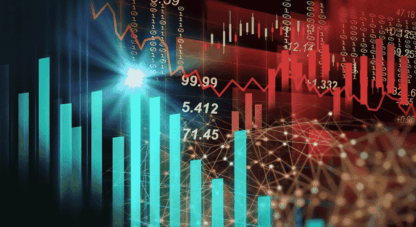We’ve recently been discussing the tension (at best) or war (at worst) between centralization and decentralization. Our intention is not to beat a dead horse. First, the horse is alive and well, and second, no beating is involved. We’re just studying him to see if he’s better off in the herd or taking off across the veld on a solo tear—or being able to do both.
It’s a huge issue, and one with perennial application. History is full of examples of decentralized societies becoming centralized and then breaking apart. (We’ve mentioned many of them in earlier posts in this space.) Any way you slice it, the matter matters—a lot. It might not interest you, but it affects you immensely.
Even the cryptocurrency vs. gold discussion last week was a variation on the theme. Both cryptos and gold are perceived to aid the cause of decentralization, and most knowledgeable citizens would prefer that they be used in that way. But of course central banks are by far the biggest accumulators of gold today, and countries around the globe are studying ways to outlaw cryptos and create central bank digital currencies.
To illustrate how centralization and decentralization might be balanced, we used the metaphor of a solar system that has gravity (between the sun and the planets, for instance) and centrifugal force (of the orbiting planets). It’s a nice metaphor, but our solar system certainly seems to be far more balanced than any political system on earth.
Interestingly, gravity is not necessarily stronger than centrifugal force—our system is pretty well balanced, after all—but gravity is inherent in bodies that have mass. Centrifugal force depends on movement.
Similarly, political centralization is inherent in bodies that have human nature. People who seek to govern populations naturally tend to lust for power. And a lust for power naturally leads to centralization.
Resisting that gravity entails movement on the part of citizens. Not just any movement—daily activities help only marginally—but movement that creates centrifugal force. Not to escape gravity, but to balance it. Such movement does not seem to come easily to large populations. Even when they attain it they maintain it only with great difficulty, and usually lose it in time.
The metaphor breaks down here—populations are not as homogeneous as planets—but that’s to our advantage. The example is still instructive because in people it also applies to individuals, not just populations. If you want to want to survive a massive centralization, you have to move. You have to do some things to give yourself options when others have none. And that is largely what the below publications and the McAlvany companies are about.
One further point about cryptocurrencies in this context: Our electrical grid is highly centralized. Both physical and computer attacks on it are increasing. If it goes down, cryptocurrencies quickly go from being “worth something” to being “potentially worth something, depending on whether we can get the grid up again.” It’s hard to trade potential for necessities in a crisis. Heck, it’s hard to trade potential for necessities in good times.
And while it might be somewhat difficult to trade gold for necessities in good times, it’s easy in crisis. And it’s always easy to trade gold for a currency more familiar to those you must do business with—and that’s true around the world. Food for thought (and action).
Key Takeaways:
- Human action and markets
- Equities revive—for now
- Beggars can’t be emperors
- Getting gold on the cheap
The McAlvany Weekly Commentary: Long Term Gold Bull Takes A Short Breath
David and Kevin begin this week’s program with some useful and high-level observations on what’s happening with markets and the way similar situations have resolved in the past. They discuss why the Fed can’t let the market set interest rates, why the government can’t cut its budget significantly, and how these things affect inflation. They also provide helpful insight on how the gold market will likely act going forward, and then turn their analysis to such market influences as the Dow-gold ratio, Fibonacci numbers, and geographical buying patterns around the world. To show how erratic market moves can be, they focus on recent market darling Nvidia. Recent sentiment has viewed it as a failsafe moneymaker, but some historical perspective on the subject reveals its feet of clay. Key to understanding market moves in stocks such as Nvidia is knowing the motivations and actions of buyers and sellers. That’s what markets consist of, after all. But the obvious is not always apparent, which is why analysis such as this can be so immensely insightful and helpful.
Credit Bubble Bulletin: Opposite Day
Doug covers a remarkable week from start to finish in clear and thorough fashion. “So much for ‘risk off,’ at least for the week.” Equities staged a surprise rally, jostling other markets in the process and making for a wild ride. The details are here, interesting in a way that only Doug can make them with such rapid-fire data. Of course, it’s not just data. The narrative tying it together is interspersed at intervals: “The bulls have plenty of fight.” “Intel’s earnings miss…was another important indication that all is not well in the semiconductor space.” “The equities rally didn’t give fragile global bonds the warm and fuzzies. Neither did U.S. price data.” “The Bank of Japan just can’t stop playing with fire.” “Global inflation is surprising to the upside.” And much more. True to form, Doug follows his own well-informed analysis with that of other analysts who are quoted in context on a number of important developments: “Market concerns are mounting that currency instability is about to intensify.” ” The swaps market is flashing warnings there could be a dash for dollar liquidity on a scale last seen at the start of the pandemic.” “China’s state-directed economy may be creating the conditions for a new wave of bond defaults that could come as soon as next year.” Says Doug of China’s current policies in a number of areas: “If I were advising Beijing on measures necessary to underpin the renminbi, I’d start with a simple proposition: have an Opposite Day.”
Hard Asset Insights: We Are In It Now
Morgan points out a key change in the way the Fed is able to influence the US economy. “The market’s collective calculus is that as inflation data heads higher, rate cut expectations should drop. That analysis is clean, straightforward, simple, and historically correct.” And it’s how things have worked for a long time, but things have changed. “The rate cut calculus is no longer simple… Monetary policy must now be viewed through the prism of a much more complex multidimensional set of variables.” He then takes us through the extremely difficult choice facing the Fed: rates must be raised or inflation will accelerate and wreak havoc on the economy. But rates must be lowered or the government will not be able to pay the interest on its debt. Either outcome will bring hardship to the Fed, the government, and all Americans. The devastating effects of runaway inflation on populations are well documented, but Morgan also quotes Niall Ferguson on what happens to nations when their payments on national debt exceed spending on their defense.
Golden Rule Radio: Gold & Silver Prices Firmer After Short Breath
After summarizing the week’s developments in the metals markets, Miles, Rob, and Tory offer thoughts on where things might go from here. Tory observes that “occasionally gold will predict…but mostly it reacts.” And that reaction can be to news or to underlying fundamentals. We’ve recently seen Treasury yields, the dollar, and gold being up at the same time, which is unusual. Typically, when the first two are up, gold is down. Counterintuitively, they point out that geopolitical developments tend not to be long-term drivers of gold price. The hosts also clarify the mission of Golden Rule Radio, which is a tight focus on the precious metals and related matters. They point listeners with more wide-ranging concerns to the other publications summarized here. Tory makes a key observation for those who fear they have missed out on gold’s recent rise. He gives them an option that for all intents and purposes allows them to purchase gold at $1,900/oz. If that doesn’t get your attention, you should probably be listening to advice from stock or bond analysts.















